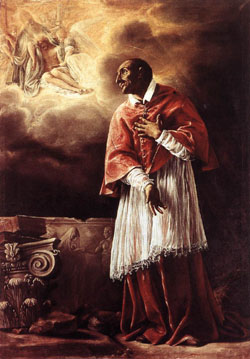Saint Charles Borromeo


The Responsibility of Men
There is one man who until today is the Emperor of Emperors, the perfect and definitive pattern for all Emperors. This is so true that when one thinks about an Emperor, one thinks foremost of him. He is Charlemagne. After Charlemagne died, the invasions that he had stopped, began again; the Empire that he had built, broke up; the Europe that he wanted to unite, fragmented into many kingdoms and smaller political units; the dynasty he founded, was extinguished. Everything would lead to the conclusion that his memory would disappear. But Charlemagne remained forever in the memory of all men as the prototype of the Catholic Emperor, and, therefore, the Emperor par excellence. The memory of Charlemagne endured with all the imperial dignity, plenitude of personality, and elevation of spirit proper to an Emperor sent by God to do His work on earth.
Louis XIV is the French King par excellence, the Sun King; Philip II of Spain was par excellence, the King who defended the Faith. In the same way, you can find other personages who personified all the facets of the roles they exercised.
The same rule applies inside the Holy Church of God. St. Gregory VII was the Pope par excellence, St. John Baptist Vianney was the model for all parish priests, and St. Charles Borromeo was the prototype of a Bishop.
As a true Pastor who watches over his flock, he was alert to the way error was being presented at his time and took a strong position against it. Like many other preeminent figures of the Counter-Reformation, he helped Catholic doctrine progress by developing the doctrine that Protestantism denied. In his written works, he deduced new developments from truths already known. His position was always militant, as a Bishop should be. He was not an ecumenical Prelate who accepts little parts of truth that the error might have in order to appease the heretic. He would analyze the ensemble of the heresy he was dealing with and discern its ultimate bad intentions. Then he would refute the error in these malicious points and develop the opposite doctrine of the Church.
St. Charles Borromeo was not only a great Bishop of the Counter-Reformation, but in a certain sense he was the Bishop of the Counter-Reformation. This title is his not just because he was a very learned man, but rather because he became the very archetype of a Bishop. He was not satisfied with writing books against the errors of the time, which he did. But he did even more; he personified the truths he defended in his books. He became the very symbol of what he wrote.
I could describe various facets of St. Borromeo that made him a model Bishop if I had more time. But this would make me late for the meeting that follows this one. So let me summarize his life in an example I find very significant.
A Cardinal, as you know, is supposed to dress with pomp, grandeur, and solemnity to glorify Our Lord Jesus Christ before men. In addition to being a Prince of the Church, St. Charles Borromeo was a temporal Lord in Milan, born into a great and noble Italian family.
That is to say, the silks and crystals of the luxurious carriage were meant to be seen by the people to glorify God and the dignity of his post. Underneath the splendid appearance of a Cardinal, the Saint continued to practice penance for his sins and those of his flock.
We can ask St. Charles Borromeo to intercede with Our Lord and Our Lady for several things on his feast day:
For ourselves personally, we might ask him to give us his vigilance against heresy and his heroic sense of sacrifice.
(Written by a Roman Catholic Priest).